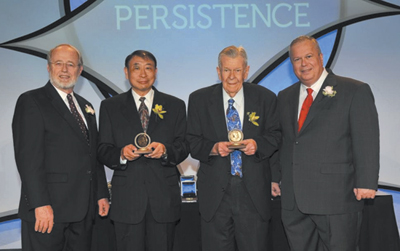Four SID Members Receive Major Awards
Society for Information Display members Thomas Peter Brody, Bernard J. Lechner, and Fan Luo recently received IEEE Jun-ichi Nishizawa Medals for their pioneering contributions to TFT-LCD technology. Member Ching Tang received the Wolf Prize in the field of chemistry for his work with OLEDs.
IEEE Jun-ichi Nishizawa Medal Winners
The IEEE Jun-ichi Nishizawa Medal was established in 2002 in honor of Japanese Engineer Jun-ichi Nishizawa and his lifetime of achievements, including work with fundamental semiconductor materials and devices, optical communications, and power systems. The medal is awarded for outstanding contributions to material and device science and technology, including practical application.
According to IEEE's announcement: "Hundreds of engineers have contributed to the innovations responsible for the current success of TFT-LCDs used in today's televisions, laptops, and mobile phones. However, it was the pioneering contributions and persistent efforts of Lechner and Brody in the 1960s and Luo in the 1970s that set the stage for the technology we see today. The trio overcame the initial limitations of using liquid crystals to display complex moving images to make the dream of being able to hang a television on the wall a reality."
Thomas Peter Brody

SID Fellow Thomas Peter Brody was a pioneer in the field of thin-film transistors (TFTs), especially their application to active-matrix displays, which became the foundation of a major new industry. For more than a decade at Westinghouse R&D Center in Pittsburgh, PA, Brody developed many uses for thin-film transistors, including flexible circuits, aircraft power controls, industrial timers, and others. Recognizing that the active-matrix array was an ideal vehicle for driving any display medium, he dedicated his life to the development and commercialization of active-matrix displays. His department in Westinghouse built the world's first working TFT-EL displays in 1973 and the first working TFT-LCDs in 1974. Later in 1974, the team demonstrated real-time video imagery using both types. Brody coined the term "active matrix."
In 1979, he founded Panelvision Corporation, the world's first AMLCD company, which introduced AMLCD products to the U.S. market in 1983. In addition to consulting, Dr. Brody founded a series of companies including Magnascreen Corporation, Active Matrix Associates, and Advantech US.
Dr. Brody was a Fellow of the Society for Information Display and a recipient of many awards, including a SID Special Recognition Award and the SID Karl Ferdinand Braun Prize. During his lifetime, he published over 70 scientific papers and received more than 60 patents. He was born in Hungary and received his bachelor's and doctorate degrees from the University of London, U.K. (Note: Dr. Brody passed away in September 2011. His obituary appears in the October 2011 issue of Information Display.)
Bernard J. Lechner
While working at RCA Laboratories in the 1960s, Bernard J. Lechner became the first researcher to analyze the limitations of early liquid-crystal cells, which had poor responsivity in handling complex images. As an alternative to simple matrix addressing, Lechner pursued addressing schemes that later became known as "active-matrix" addressing. He conceived the basic idea of associating a field-effect transistor (FET) and a capacitor with each cell of an LCD panel to selectively store and control the brightness of the cell. In 1968, using a 36-element LCD and discrete FETs, he demonstrated moving gray-scale images at full NTSC television rates, thus showing that the active-matrix concept had the capability for television displays of the future. It could not be built as an integrated structure at the time, but Lechner's transistor-capacitor addressing circuit is what is used in today's active-matrix LCDs. He first published this concept in 1969.
Lechner is a Fellow of the Society for Information Display as well as a Fellow of the IEEE and the Society of Motion Picture and Television Engineers (SMPTE). His many honors include the SID Frances Rice Darne Award in 1971, the Advanced Television Systems Committee Outstanding Achievement Award (now called the Bernard J. Lechner Award), and the SMPTE Progress Medal. He received his bachelor's degree in electrical engineering from Columbia University. Lechner is currently a consultant residing in Princeton, New Jersey.
Fang-Chen Luo
Working at Westinghouse during the 1970s, both Peter Brody and Fang-Chen Luo extended Lechner's active-matrix work, and, based on CdSe TFT technology developed by Brody during the 1960s, produced the first LCDs employing an integrated array of TFTs. Brody led the research group for which Luo fabricated the displays.
In 1973 and 1974, Luo and his team at Westinghouse made working 5 x 5-in. 100 x 100-pixel TFT-addressed panels. The results were reported by Time magazine in a 1974 issue with a picture of Luo holding a working panel. The article described a "picture on the wall." Notes Luo, "It was a little far-fetched to think of going from a 5 x 5-in. panel to a picture on the wall. At that time, I never dreamed that TFT-LCD panels could reach 80 in. on the diagonal, with contrast ratios over 1,000.000:1 and with more than 1 million colors. The ubiquitous applications and the over US$10 billion market value of TFT-LCD panels were beyond our imaginations at that time.
"All of these achievements were primarily due to the efforts made by TFT-LCD engineers all over the world in continuously improving the performance and manufacturability of TFT-LCD panels. I particularly express my gratitude to Dr. Brody for hiring me, assigning me the TFT-display projects, and being a mentor to me at Westinghouse."
An IEEE Life Member, Luo is also a Fellow of the Society for Information Display. His honors include a SID Special Recognition Award and an Outstanding Industrial Innovation Award and Gold Panel Award, both from the Taiwan's Ministry of Economic Affairs. He received his bachelor's degree in electrical engineering from Cheng Kung University and his master's and doctorate degrees from Northwestern University. Luo is currently Chief Intellectual Property Officer and Vice-President at AU Optronics Corp., Hsinchu, Taiwan.

Fang-Chen Luo (second from left) and Bernard J. Lechner (second from right) receive their IEEE Jun-ichi Nishizawa medals.
Wolf Prize Winner Ching Tang
Wolf Prizes are awarded by the Wolf Foundation every year in four out of five categories: agriculture, chemistry, mathematics, medicine, and physics. A total of 262 scientists from around the world have been honored with this prize over the past 33 years. One out of every three Wolf Prize Laureates in chemistry, physics, and medicine has later received a Nobel Prize.
Ching Tang

SID member Ching Tang recently received the 2011 Wolf Prize in Chemistry. He shares the prize with Professor Stuart Alan Rice of the University of Chicago and Professor Krzystof Matyjaszewski of Carnegie Mellon University.
Tang is the inventor of the organic light-emitting diode (OLED). When he published his seminal paper on the technology in 1987 (along with Steve Van Slyke) in the journal Applied Physics Letters, he was employed by the Eastman Kodak Company.
In addition to the discovery of OLEDs, Tang has been credited with a number of key innovations leading to the commercialization of new flat-panel display technology, including the development of robust luminescent materials, novel color pixilation methods, fabrication processes for the manufacture of OLED displays, and the adaptation of technology for high-definition OLED displays. Tang also is widely recognized for his early work in photovoltaics.
Prior to joining the University of Rochester in the fall of 2006, Tang was a Distinguished Research Fellow at Eastman Kodak Company. He is a member of the National Academy of Engineering and a Fellow of the American Physical Society and the Society for Information Display. He holds more than 70 U.S. patents and has published 70 papers.
– Jenny Donelan